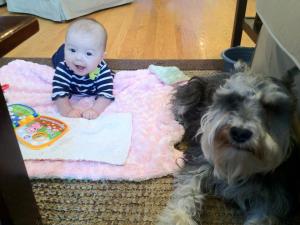
I came across your site while I was desperately surfing the net to find someone who can help me with an issue I have with one of my dogs. My husband and I live in Dubai and we have 2 dogs mixed breed dogs that get along really well.
One of our dogs, Bailey, is literally scared of anyone. He is fine with us petting him but he is not ok with anyone else. He was about 2 months when we got him and he was scared then. I thought it would pass by eventually.
The major problem I have with Bailey is that I can’t get him to walk on the leash, so whenever we need to take him out to the vet or grooming salon, we have to carry him! So we don’t do walks with him because he runs away whenever I take the leash. I was hoping you could guide me with some points of action.
Warm Regards,
A Concerned Owner
Dear Concerned Owner,
Thank you for your e-mail. I hope these guidelines will be of some use to you–know that they are my personal opinion and fit in with my personal training philosophy of positive reinforcement and intervention.
I had a dog who was very fearful, so I am familiar with the issues involved with fearful dogs and them “shutting down” and needing to be carried. Let me say that with fearful dogs it is all about TRUST which takes a long, long time. Take small steps, knowing that this issue is far harder to cure than aggression or dominance because of the time it takes to cure. But it is possible!! Here are some thoughts for you to consider.
1) When you pet a dog, you are rewarding their state of mind whether you mean to or not. When a baby is scared, you pick it up and comfort it, but that is
not what you should do with dogs. When you pet a fearful dog you are telling him “keep being scared, and I will keep giving you attention”. It is impossible to correct fear through affection; you cannot love your dog into being unafraid. When Bailey is afraid, it is best to not give him any touch, any eye contact, or any vocal attention. Ignore the issue. By ignoring you will be transferring the message “there is nothing to worry about”. Read more about the the right time to give affection
here.
2) To help Bailey with his issue of fearing people and strangers, you need to instruct visitors to not look at, touch, or talk to Bailey. Just have them completely ignore him. Dogs learn to trust through smell, then sight, then sound. Once enough visitors come through without giving any attention to Bailey at all, he will want to experience them in this order: sniffing them (continue to ignore!), then looking at them, and then being touched/talked to.
3) I agree with you, that the biggest issue is not being able to walk Bailey. The longer a dog goes without walking, the more energy he will have built up into his system, and the longer he will fight you to not have to face his fear. The first thing I would do is put a leash on him, and let him do something he loves (ex. eat, play with a ball, given a bone, etc) and don’t touch the leash, let him drag it around. He needs to associate the leash with something good, not with something bad (remember, this takes time). Then he needs to learn that wearing a leash means forward motion. In order to teach him this, you need to show him some tough love. Don’t look at him or talk to him, but apply gentle pressure to the leash (ex. pull on the leash with just two fingers). Don’t release the tension until he makes any kind of forward movement. As soon as he steps forward reward him by relaxing the tension. Then do it again, and again. Do this only inside the house until he is moving in any direction with the leash on (may take days!). Then I would carry him/drive him to an area he has never been before (he may associate outside your front door with fear since that has always been his battleground). Then do the same thing outside: apply steady pressure on the leash until he moves, then reward him by relaxing the tension. When you encounter something that makes him fearful, practice no touch, no talk, and no eye contact. Then ask him to move forward again.
Lastly, I am a firm believer in treadmills since it forces the fearful dog to move forward. If you have access to one, please read my article on
treadmills!
Hope these things give you something to think about. You CAN make Bailey the dog of your dreams!
Lead your dog!












